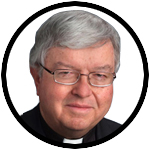
Father Kenneth Doyle
Q. I confessed a grave sin more than 40 years ago and received absolution for it. I have, however, been haunted by this over the years and still feel guilt. My sin was that I had taken my 16-year-old daughter to our family doctor to have an abortion. So I not only committed a serious sin myself but caused her to do the same.
We both confessed these sins to our priest. But now I continue to be plagued by that memory. Am I committing another sin now by not trusting enough in God’s mercy? (City of origin withheld)
A. No, you are not committing another sin. On the intellectual level, you acknowledge that God has forgiven you; on the emotional level, you are just having a hard time feeling God’s mercy. And wrapped up in all of this are the long-term psychological effects of abortion.
Many years ago, a young woman told me: “My roommates in college told me to have an abortion, and I did. But where are they this week, when it would have been my daughter’s third birthday — and I am all by myself to think about what that would have been like?”
[hotblock]
But God’s forgiveness is wider than we can ever imagine. I am guessing that you and I are contemporaries; and when many Catholics our own age grew up, our primary image of God was of a giant scorekeeper in the sky, keeping track of our misdeeds.
Now, though — and thankfully — my image of God is much different: I picture God first of all as the father of the prodigal son — running down the road to throw his arms around his wayward child who has come back. The boy wants to pour out his story of sorrow, but the father says, “It doesn’t matter now. You’re home. Let’s have a party.”
And Jesus told that story to let us know that this is just the way his Father forgives us when we come back to him.
Q. It is well-known that for several centuries in the early days of the church, there were priests who were married — including St. Peter and probably most of the other apostles. Today, if a married male Episcopal priest converts to Roman Catholicism, he can be permitted to remain married and still become a Roman Catholic priest.
So here’s my question: Is there not discrimination in permitting these men to be married, while not allowing that same option to Catholic men who would like to become priests were it not for the celibacy rule? (Terre Haute, Indiana)
A. St. Peter was certainly married, because he had a mother-in-law who was healed of an illness by Jesus (Lk 4:38-39). Although we have no direct documentary evidence, it is likely that most of the other apostles were also married. (St. Paul says in 1 Corinthians 9:5, “Do we not have the right to take along a Christian wife, as do the rest of the apostles, and the brothers of the Lord, and Cephas?”)
Throughout the early centuries of the church’s history, clergy continued to be married, and it was not until the 11th century that celibacy became a universal requirement for priestly ordination in the Latin-rite church. (Catholic churches of the Eastern rites have continued to allow clergy to marry before their ordination.)
In 1980, a pastoral provision of Pope John Paul II permitted former Anglican clergy who had converted to Catholicism to be ordained as Roman Catholic priests even though they continued to be married. That provision has since been applied in the United States to about 120 clergy — primarily former Anglican (Episcopal) priests.
To your question, I don’t see this pastoral provision as discriminating against priests like myself who have been lifelong Catholics, since we chose to commit freely to celibacy as a condition for ordination. What it does highlight, though, is that clerical celibacy is not a revealed truth but a matter of church discipline, which can always be re-evaluated in particular situations.
An upcoming (2019) synod of Catholic bishops of the Amazon region of South America will discuss — with the approval of Pope Francis — the possibility of ordaining married men “of proven virtue” to minister to Catholics in that specific area of the world, where there are 10,000 Catholics for every priest. By comparison, in the U.S., the ratio is about 1,800 to one.
***
Questions may be sent to Father Kenneth Doyle at askfatherdoyle@gmail.com and 30 Columbia Circle Dr., Albany, New York 12203.
PREVIOUS: Easter invites us to rejoice, to reflect and to renew the world
NEXT: Life brings challenges of doubt, yet the risen Jesus brings peace



Father Doyle,
Thank you for your response in “Spirituality” — “You know you’re absolved, but you don’t feel forgiven.” I too had a similar problem and have a hard time getting past it. Your answer has helped to find a way out of my dilemma.